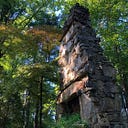Member-only story
Why Would I Want to do a Study Travel in Poland?
This upcoming May, if all goes well with the world, I’ll be co-leading a travel study trip to Poland with students. Over the past few months, I have been starting to read and study, as any educator does and in much more detail than I ever have before, about Poland during World War II. I gave a talk in Warsaw back in December 2018, and during my time there, I visited various sites such as the National Gallery, the Uprising Museum, remnants of the ghetto wall, and more. I did not get the opportunity to go to Treblinka, and I never made it down to Kraków and Auschwitz. Since my three-day trip, I’ve been thinking about Poland a lot, partly due to the connection I’ve made with Michał Choiński from the Institute of English Studies at Jagiellonian University in Kraków. It is through Choiński that I’ve really started to think about the connections between Poland and the Southern United States.
This connection served, in many ways, as the impetus for the proposal to do a study travel to Poland. In the fall of 2019, I hosted Choiński at my university for a talk about his exploration of the work of Lillian Smith in his book Southern Hyperboles: Metafigurative Strategies of Narration. During our conversations, and during his talk, Choiński pointed out William Styron drew a direct comparison between the locales. In Sophie’s Choice, a novel that contains the interactions…
